2019 HYUNDAI SONATA HYBRID cruise control
[x] Cancel search: cruise controlPage 384 of 546
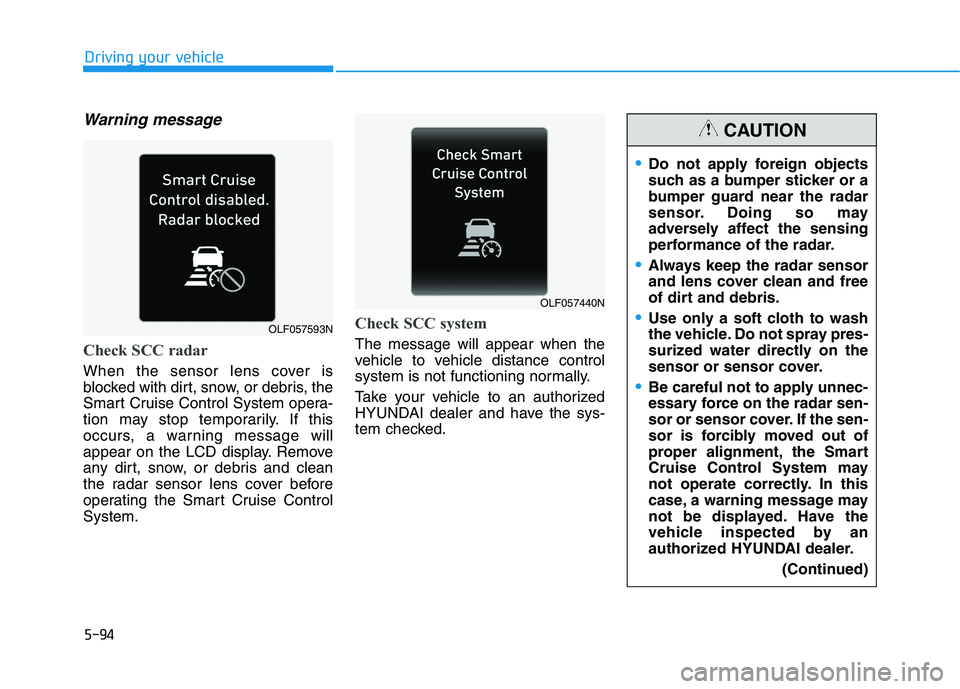
5-94
Driving your vehicle
Warning message
Check SCC radar
When the sensor lens cover is
blocked with dirt, snow, or debris, the
Smart Cruise Control System opera-
tion may stop temporarily. If this
occurs, a warning message will
appear on the LCD display. Remove
any dirt, snow, or debris and clean
the radar sensor lens cover before
operating the Smart Cruise ControlSystem.
Check SCC system
The message will appear when the
vehicle to vehicle distance control
system is not functioning normally.
Take your vehicle to an authorized
HYUNDAI dealer and have the sys-
tem checked.
Do not apply foreign objects
such as a bumper sticker or a
bumper guard near the radar
sensor. Doing so may
adversely affect the sensing
performance of the radar.
Always keep the radar sensor
and lens cover clean and free
of dirt and debris.
Use only a soft cloth to wash
the vehicle. Do not spray pres-
surized water directly on the
sensor or sensor cover.
Be careful not to apply unnec-
essary force on the radar sen-
sor or sensor cover. If the sen-
sor is forcibly moved out of
proper alignment, the Smart
Cruise Control System may
not operate correctly. In this
case, a warning message may
not be displayed. Have the
vehicle inspected by an
authorized HYUNDAI dealer.(Continued)
CAUTION
OLF057440N
OLF057593N
Page 385 of 546
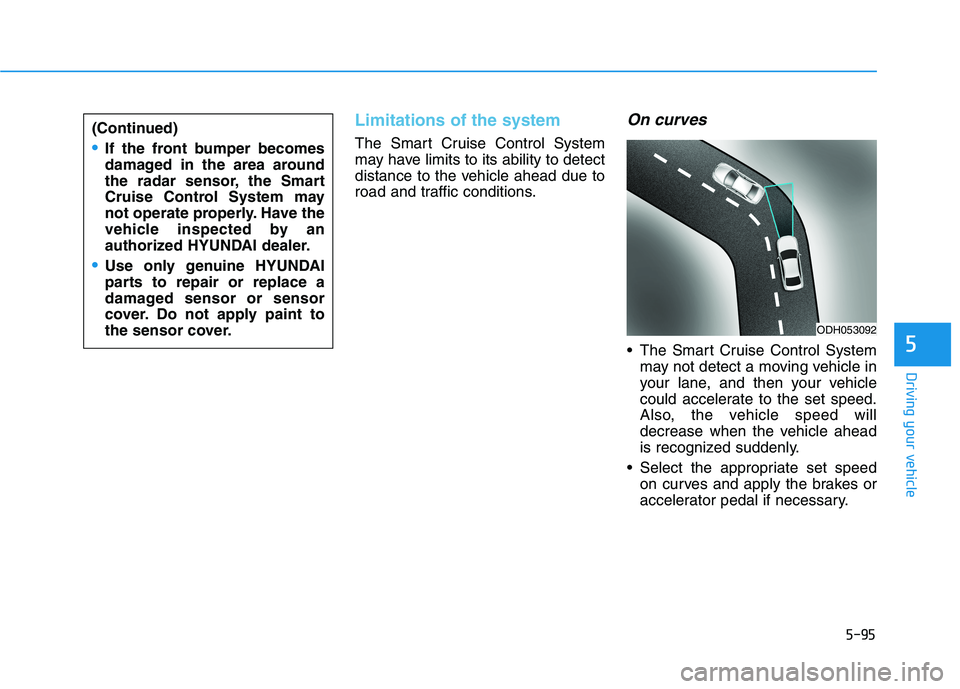
5-95
Driving your vehicle
5
Limitations of the system
The Smart Cruise Control System
may have limits to its ability to detect
distance to the vehicle ahead due to
road and traffic conditions.
On curves
The Smart Cruise Control Systemmay not detect a moving vehicle in
your lane, and then your vehicle
could accelerate to the set speed.
Also, the vehicle speed will
decrease when the vehicle ahead
is recognized suddenly.
Select the appropriate set speed on curves and apply the brakes or
accelerator pedal if necessary.
ODH053092
(Continued)
If the front bumper becomes
damaged in the area around
the radar sensor, the Smart
Cruise Control System may
not operate properly. Have the
vehicle inspected by an
authorized HYUNDAI dealer.
Use only genuine HYUNDAI
parts to repair or replace a
damaged sensor or sensor
cover. Do not apply paint to
the sensor cover.
Page 386 of 546
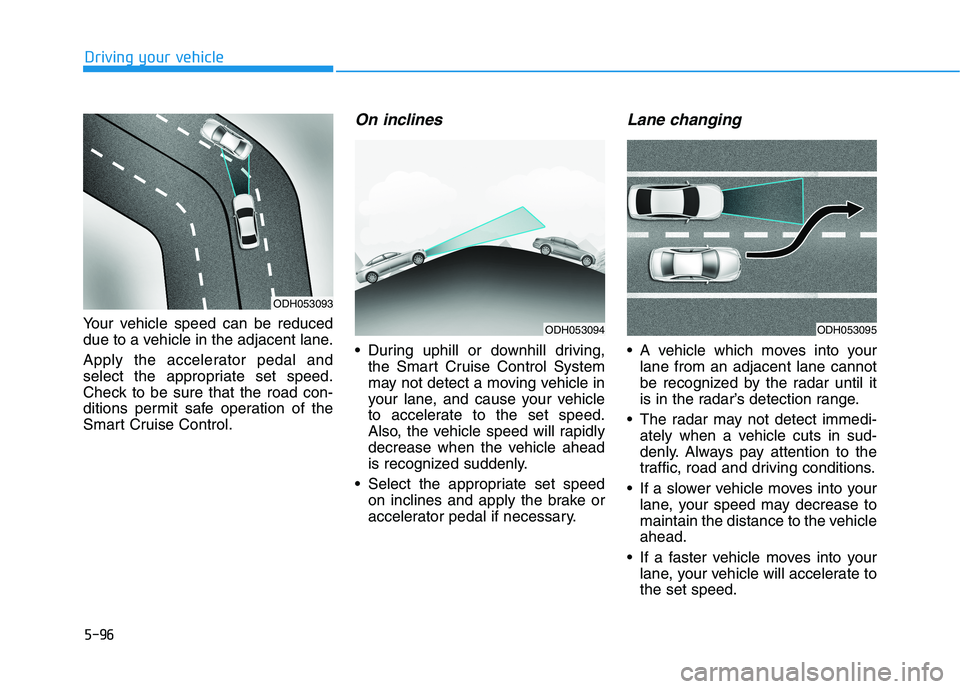
5-96
Driving your vehicle
Your vehicle speed can be reduced
due to a vehicle in the adjacent lane.
Apply the accelerator pedal and
select the appropriate set speed.
Check to be sure that the road con-
ditions permit safe operation of the
Smart Cruise Control.
On inclines
During uphill or downhill driving,the Smart Cruise Control System
may not detect a moving vehicle in
your lane, and cause your vehicle
to accelerate to the set speed.
Also, the vehicle speed will rapidly
decrease when the vehicle ahead
is recognized suddenly.
Select the appropriate set speed on inclines and apply the brake or
accelerator pedal if necessary.
Lane changing
A vehicle which moves into yourlane from an adjacent lane cannot
be recognized by the radar until it
is in the radar’s detection range.
The radar may not detect immedi- ately when a vehicle cuts in sud-
denly. Always pay attention to the
traffic, road and driving conditions.
If a slower vehicle moves into your lane, your speed may decrease to
maintain the distance to the vehicleahead.
If a faster vehicle moves into your lane, your vehicle will accelerate tothe set speed.
ODH053093
ODH053094ODH053095
Page 389 of 546

5-99
Driving your vehicle
5
The Smart Cruise Control System
may not operate temporarily dueto:
Electrical interference
Modifying the suspension
Differences of tire abrasion ortire pressure
Installing different type of tires
Information
This device complies with Industry
Canada RSS-210 standard(s).
Operation is subject to the following
three conditions:
1. This device may not cause interfer- ence, and
2. This device must accept any inter- ference, including interference that
may cause undesired operation of
the device.
3. Changes or modifications not expressly approved by the party
responsible for compliance could
void the user’s authority to operate
the device.
i
NOTICE
When using the Smart Cruise
Control take the following pre-cautions:
If an emergency stop is nec-
essary, you must apply the
brakes. The vehicle cannot be
stopped by using the Smart
Cruise Control System.
Keep a safe distance accord-
ing to road conditions and
vehicle speed. If the vehicle to
vehicle distance is too close
during a high-speed driving, a
serious collision may result.
Always maintain sufficient braking distance and deceler-
ate your vehicle by applying
the brakes if necessary.
The Smart Cruise Control
System cannot recognize a
stopped vehicle, pedestrians
or an oncoming vehicle.
Always look ahead cautiously
to prevent unexpected and
sudden situations from occur-ring.
(Continued)
WARNING (Continued)
Vehicles moving in front of
you with a frequent lane
change may cause a delay in
the system’s reaction or maycause the system to react to a
vehicle actually in an adjacent
lane. Always drive cautiously
to prevent unexpected and
sudden situations from occur-ring.
Always be aware of the select-
ed speed and vehicle to vehi-
cle distance.
The Smart Cruise Control
System may not recognize
complex driving situations so
always pay attention to driv-
ing conditions and control
your vehicle speed.
Page 392 of 546

5-102
Driving your vehicle
Driving in the rain
Rain and wet roads can make driving
dangerous. Here are a few things to
consider when driving in the rain or
on slick pavement:
Slow down and allow extra follow-ing distance. A heavy rainfall
makes it harder to see and increas-es the distance needed to stop
your vehicle.
Turn OFF your Cruise Control.
Replace your windshield wiper blades when they show signs of streaking or missing areas on thewindshield.
Be sure your tires have enough tread. If your tires do not have
enough tread, making a quick stop
on wet pavement can cause a skid
and possibly lead to an accident.
See "Tire Tread" in chapter 7 .
Turn on your headlamps to make it easier for others to see you.
Driving too fast through large pud- dles can affect your brakes. If you
must go through puddles, try to
drive through them slowly. If you believe your brakes may be
wet, apply them lightly while driv-
ing until normal braking operation
returns.
Hydroplaning
If the road is wet enough and you are
going fast enough, your vehicle may
have little or no contact with the road
surface and actually ride on the
water. The best advice is SLOW
DOWN when the road is wet.
The risk of hydroplaning increas- es as the depth of tire tread
decreases, refer to "Tire Tread" in
chapter 7.
Driving in flooded areas
Avoid driving through flooded areas
unless you are sure the water is nohigher than the bottom of the wheel
hub. Drive through any water slowly.
Allow adequate stopping distance
because brake performance may bereduced.
After driving through water, dry the
brakes by gently applying them sev-
eral times while the vehicle is moving
slowly.
Page 498 of 546
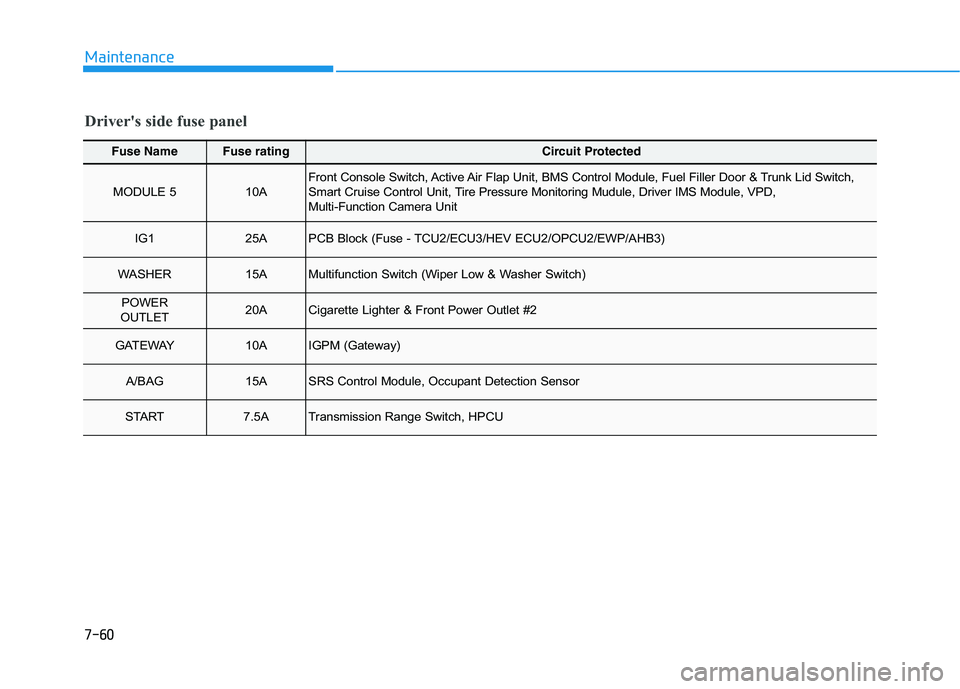
7-60
Maintenance
Fuse NameFuse ratingCircuit Protected
MODULE 510AFront Console Switch, Active Air Flap Unit, BMS Control Module, Fuel Filler Door & Trunk Lid Switch,
Smart Cruise Control Unit, Tire Pressure Monitoring Mudule, Driver IMS Module, VPD,
Multi-Function Camera Unit
IG1 25APCB Block (Fuse - TCU2/ECU3/HEV ECU2/OPCU2/EWP/AHB3)
WASHER 15AMultifunction Switch (Wiper Low & Washer Switch)
POWER
OUTLET20ACigarette Lighter & Front Power Outlet #2
GATEWAY10AIGPM (Gateway)
A/BAG 15ASRS Control Module, Occupant Detection Sensor
START7.5ATransmission Range Switch, HPCU
Driver's side fuse panel
Page 540 of 546
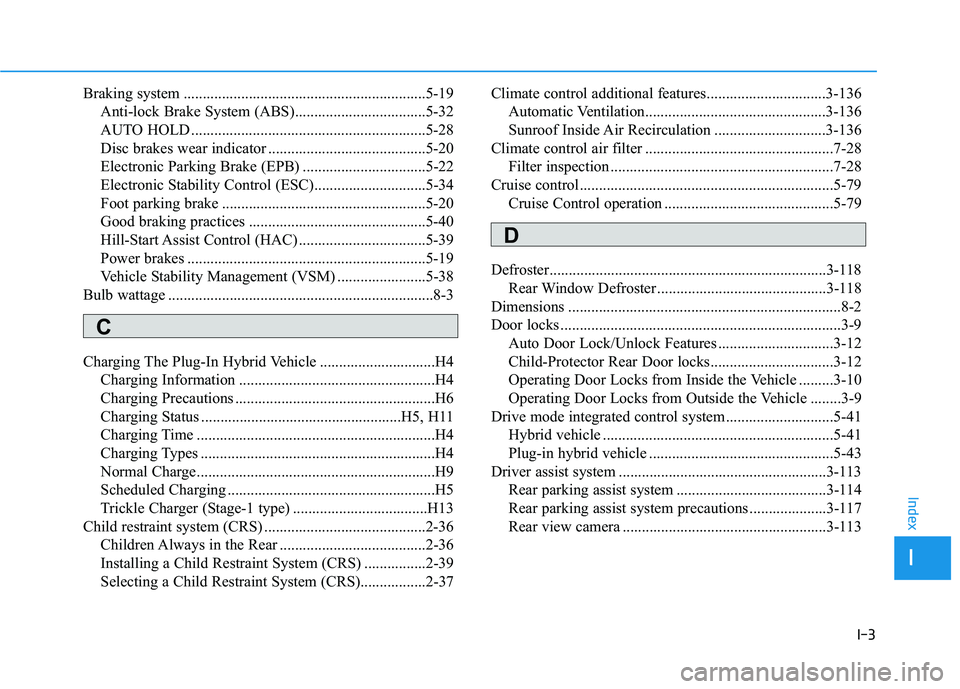
I-3
Braking system ...............................................................5-19
Anti-lock Brake System (ABS)..................................5-32
AUTO HOLD .............................................................5-28
Disc brakes wear indicator .........................................5-20
Electronic Parking Brake (EPB) ................................5-22
Electronic Stability Control (ESC).............................5-34
Foot parking brake .....................................................5-20
Good braking practices ..............................................5-40
Hill-Start Assist Control (HAC) .................................5-39
Power brakes ..............................................................5-19
Vehicle Stability Management (VSM) .......................5-38
Bulb wattage .....................................................................8-3
Charging The Plug-In Hybrid Vehicle ..............................H4 Charging Information ...................................................H4
Charging Precautions ....................................................H6
Charging Status ....................................................H5, H11
Charging Time ..............................................................H4
Charging Types .............................................................H4
Normal Charge..............................................................H9
Scheduled Charging ......................................................H5
Trickle Charger (Stage-1 type) ...................................H13
Child restraint system (CRS) ..........................................2-36 Children Always in the Rear ......................................2-36
Installing a Child Restraint System (CRS) ................2-39
Selecting a Child Restraint System (CRS).................2-37 Climate control additional features...............................3-136
Automatic Ventilation...............................................3-136
Sunroof Inside Air Recirculation .............................3-136
Climate control air filter .................................................7-28 Filter inspection ..........................................................7-28
Cruise control..................................................................5-79 Cruise Control operation ............................................5-79
Defroster........................................................................3-118 Rear Window Defroster ............................................3-118
Dimensions .......................................................................8-2
Door locks .........................................................................3-9 Auto Door Lock/Unlock Features ..............................3-12
Child-Protector Rear Door locks................................3-12
Operating Door Locks from Inside the Vehicle .........3-10
Operating Door Locks from Outside the Vehicle ........3-9
Drive mode integrated control system ............................5-41 Hybrid vehicle ............................................................5-41
Plug-in hybrid vehicle ................................................5-43
Driver assist system ......................................................3-113
Rear parking assist system .......................................3-114
Rear parking assist system precautions ....................3-117
Rear view camera .....................................................3-113
I
Index
C
D
Page 545 of 546
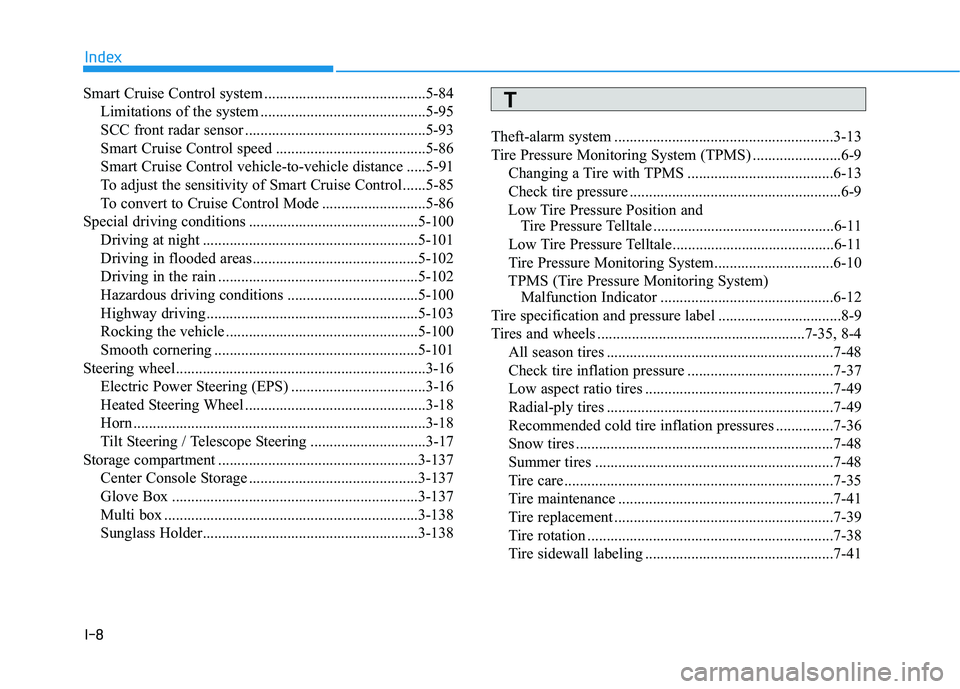
I-8
Smart Cruise Control system ..........................................5-84
Limitations of the system ...........................................5-95
SCC front radar sensor ...............................................5-93
Smart Cruise Control speed .......................................5-86
Smart Cruise Control vehicle-to-vehicle distance .....5-91
To adjust the sensitivity of Smart Cruise Control ......5-85
To convert to Cruise Control Mode ...........................5-86
Special driving conditions ............................................5-100 Driving at night ........................................................5-101
Driving in flooded areas ...........................................5-102
Driving in the rain ....................................................5-102
Hazardous driving conditions ..................................5-100
Highway driving.......................................................5-103
Rocking the vehicle ..................................................5-100
Smooth cornering .....................................................5-101
Steering wheel.................................................................3-16 Electric Power Steering (EPS) ...................................3-16
Heated Steering Wheel ...............................................3-18
Horn ............................................................................3-18
Tilt Steering / Telescope Steering ..............................3-17
Storage compartment ....................................................3-137
Center Console Storage ............................................3-137
Glove Box ................................................................3-137
Multi box ..................................................................3-138
Sunglass Holder........................................................3-138 Theft-alarm system .........................................................3-13
Tire Pressure Monitoring System (TPMS) .......................6-9
Changing a Tire with TPMS ......................................6-13
Check tire pressure .......................................................6-9
Low Tire Pressure Position and Tire Pressure Telltale ...............................................6-11
Low Tire Pressure Telltale..........................................6-11
Tire Pressure Monitoring System...............................6-10
TPMS (Tire Pressure Monitoring System) Malfunction Indicator .............................................6-12
Tire specification and pressure label ................................8-9
Tires and wheels ......................................................7-35, 8-4 All season tires ...........................................................7-48
Check tire inflation pressure ......................................7-37
Low aspect ratio tires .................................................7-49
Radial-ply tires ...........................................................7-49
Recommended cold tire inflation pressures ...............7-36
Snow tires ...................................................................7-48
Summer tires ..............................................................7-48
Tire care ......................................................................7-35
Tire maintenance ........................................................7-41
Tire replacement .........................................................7-39
Tire rotation ................................................................7-38
Tire sidewall labeling .................................................7-41
Index
T